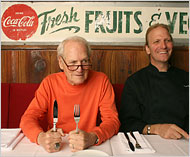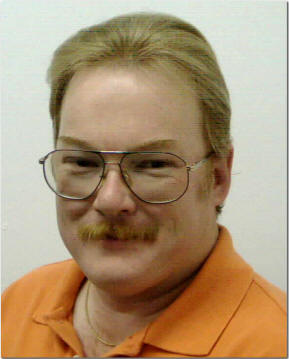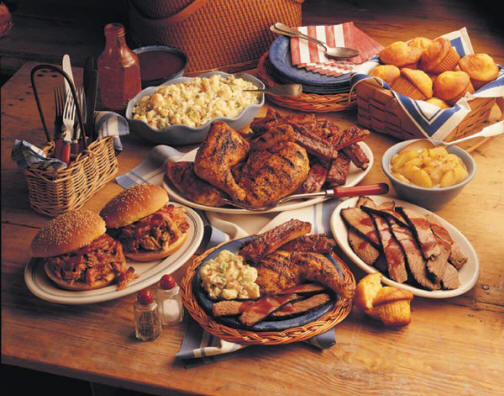I travel from coast to coast seeing plays for The Wall Street Journal, which means that I eat out a lot. Two weeks ago, for instance, I dined at Dressing Room, a restaurant in suburban Connecticut that is attached to the Westport Country Playhouse, where I saw a production of Alan Ayckbourn’s Time of My Life that was very impressive. So was my dinner.
 Dressing Room, which bills itself as “A Homegrown Restaurant,” is a joint venture of Paul Newman (yes, that Paul Newman–his wife runs the theater next door) and celebrity chef Michel Nischan. Newman is by all accounts a hands-on boss, but his partner dreams up the dishes, most of which are gussied-up big-ticket versions of “regional American heirloom recipes.” One of them, I noted with astonishment, was described on the dinner menu as “Niman Ranch baby back ribs, Scott County Missouri-style.”
Dressing Room, which bills itself as “A Homegrown Restaurant,” is a joint venture of Paul Newman (yes, that Paul Newman–his wife runs the theater next door) and celebrity chef Michel Nischan. Newman is by all accounts a hands-on boss, but his partner dreams up the dishes, most of which are gussied-up big-ticket versions of “regional American heirloom recipes.” One of them, I noted with astonishment, was described on the dinner menu as “Niman Ranch baby back ribs, Scott County Missouri-style.”
 Why was I astonished? Because Smalltown, U.S.A., the place where I grew up and where most of my family still lives, is located in Scott County, where smoked meat is a food group. I’ve eaten plenty of barbecue there, much of it at a place called Dexter Bar-B-Que whose ribs are admired throughout southeast Missouri. It went without saying that I had to see for myself what manner of barbecued rib a celebrity chef and a movie star would attempt to fob off on a bunch of unsuspecting New Englanders, so I ordered an appetizer-sized portion, took a suspicious nibble, and commenced (as they say back where I come from) to hollering. M. Nischan’s ribs are light-colored, delicately seasoned, meltingly tender, and ambrosially tasty. I’ve never tasted anything like them anywhere in the world–including Scott County.
Why was I astonished? Because Smalltown, U.S.A., the place where I grew up and where most of my family still lives, is located in Scott County, where smoked meat is a food group. I’ve eaten plenty of barbecue there, much of it at a place called Dexter Bar-B-Que whose ribs are admired throughout southeast Missouri. It went without saying that I had to see for myself what manner of barbecued rib a celebrity chef and a movie star would attempt to fob off on a bunch of unsuspecting New Englanders, so I ordered an appetizer-sized portion, took a suspicious nibble, and commenced (as they say back where I come from) to hollering. M. Nischan’s ribs are light-colored, delicately seasoned, meltingly tender, and ambrosially tasty. I’ve never tasted anything like them anywhere in the world–including Scott County.
 I Googled “Scott County Missouri-style ribs” as soon as I got home and discovered that Nischan had published his rib recipe in Condé Nast Traveler a year ago. I immediately e-mailed a copy of it to my brother David, a lifelong resident of Smalltown who is also a local authority on barbecue (he serves as a judge at regional cookoffs). This was his reply:
I Googled “Scott County Missouri-style ribs” as soon as I got home and discovered that Nischan had published his rib recipe in Condé Nast Traveler a year ago. I immediately e-mailed a copy of it to my brother David, a lifelong resident of Smalltown who is also a local authority on barbecue (he serves as a judge at regional cookoffs). This was his reply:
Your ribs intrigue me. I’ve never heard of anyone in southeast Missouri or Western Kentucky cooking ribs this way. People around here dry-rub seasoning into the meat and then smoke the ribs indirectly with heat. Nischan seems to be getting the color of his meat from searing over the fire. Our meat gets its color from the seasonings and the smoke from the wood fire. I would be interested in where and from whom in Scott County he got the recipe.
So would I, though my guess is that he’s put it through a set of hoops so fancy that it bears little if any resemblance to the authentic Ur-recipe with which he presumably started. And while I liked his Scott County-style ribs a whole lot, I have to confess that I like the real thing even more.
 I should add that I speak as one whose taste in barbecue is nothing if not inclusive. I’ve eaten it everywhere from Arthur Bryant’s in Kansas City to Rub BBQ in Manhattan, my adopted home. I’m not a particularly fussy eater, and I like most of the better-known regional variations of barbecue that I’ve run across in my travels. When all is said and done, though, the kind I like best is the kind I grew up with, and I suspect that most people lucky enough to have grown up eating barbecue feel the same way about the kind they grew up with. I’ve never met anyone who underwent a full-tilt adult conversion to a different style of barbecue. Crushes, yes: I myself once experienced a brief but intense attraction to the vinegary-tasting pulled pork served in eastern North Carolina. But my underlying loyalty to the dry-rubbed rib remained, and remains, unshaken.
I should add that I speak as one whose taste in barbecue is nothing if not inclusive. I’ve eaten it everywhere from Arthur Bryant’s in Kansas City to Rub BBQ in Manhattan, my adopted home. I’m not a particularly fussy eater, and I like most of the better-known regional variations of barbecue that I’ve run across in my travels. When all is said and done, though, the kind I like best is the kind I grew up with, and I suspect that most people lucky enough to have grown up eating barbecue feel the same way about the kind they grew up with. I’ve never met anyone who underwent a full-tilt adult conversion to a different style of barbecue. Crushes, yes: I myself once experienced a brief but intense attraction to the vinegary-tasting pulled pork served in eastern North Carolina. But my underlying loyalty to the dry-rubbed rib remained, and remains, unshaken.
I further suspect that my own liking for honest-to-God Scott County-style ribs is less a matter of aesthetic preference than a manifestation of my enduring nostalgia for southeast Missouri. Hometown cooking gets in your blood: I moved away from Smalltown three decades ago, but I return home to visit my family two or three times a year, and whenever I do, I eat barbecue. My mother doesn’t cook as much as she used to, so our visits to Dexter Bar-B-Que have become a replacement (of sorts) for the fried potatoes, baked beans, waffles, and stewed chicken and noodles that she dished up in my calorie-unconscious youth.
Paradoxical as it may sound, one of the things I love most about barbecue is that it tastes different wherever you go. Once upon a time America seemed to be evolving into a giant super-nation where everyone did everything alike. A half-century ago John Steinbeck bought a camper, drove it all over the country, and wrote up his adventures in a book called Travels With Charley. One of the things he noticed, or thought he noticed, was that local accents were dying out:
Regional speech is in the process of disappearing, not gone but going. Forty years of radio and twenty years of television must have this impact. Communications must destroy localness, by a slow, inevitable process. I can remember a time when I could almost pinpoint a man’s place of origin by his speech. That is growing more difficult now and will in some foreseeable future become impossible….Just as our bread, mixed and baked, packaged and sold without benefit of accident or human frailty, is uniformly good and uniformly tasteless, so will our speech become one speech. I who love words and the endless possibility of words am saddened by this inevitability. For with local accent will disappear local tempo. The idioms, the figures of speech that make language rich and full of the poetry of place and time must go. And in their place will be a national speech, wrapped and packaged, standard and tasteless.
Maybe so, but my experience suggests otherwise. You couldn’t spend thirty seconds listening to my brother without knowing that he grew up in southeast Missouri, and Mrs. T and I had occasion last week to spend a few hours with a very nice woman from Massachusetts whose accent is strong enough to cut sheet metal. And just as our regional speech has contrived to defy the flattening effects of radio and TV, so has our regional cooking retained its individuality in spite of the ubiquity of the Big Mac. Nor should that surprise anybody: a land big enough to contain multitudes has room enough for every imaginable kind of barbecue, up to and including the fancy kind.
So I don’t mind admitting that I really, really liked Dressing Room’s not-quite-Scott-County-style ribs–as well as the fact that Messrs. Newman and Nischan went out of their way to say where they came from, tenuous though the relationship between their ribs and ours may be. Note that I still say “ours,” even though time has inevitably turned me into a Missouri-style New Yorker. I’m proud to be from Scott County. It isn’t famous for much, but I love it anyway. I was happy there, and most of the time I knew it. Remembered happiness and dry-rubbed ribs: of such humble commodities is middle-aged bliss made.
